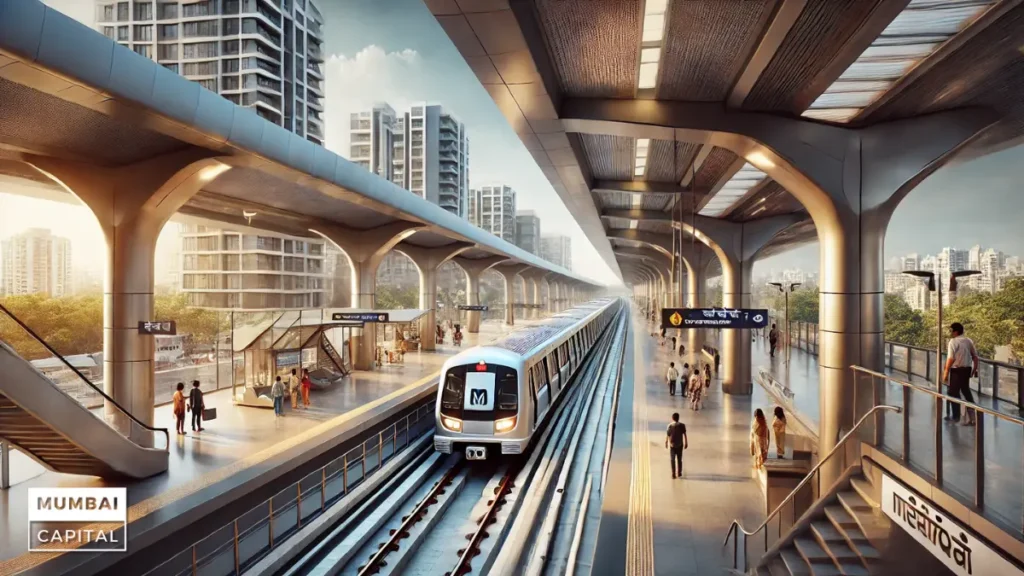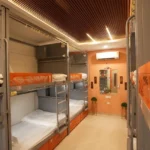The Mumbai Metro is a rapid transit system serving the city of Mumbai, India. The Mumbai Metro is a rapid transit (MRT) system serving the city of Mumbai and the wider Mumbai Metropolitan Region in Maharashtra, India. Here are some key points about the Mumbai Metro:
Overview

- Inception: The Mumbai Metro project was initiated to reduce traffic congestion in the city and provide a modern public transportation system.
- Operational Lines: The first line, Line 1, was inaugurated in June 2014, running between Versova and Ghatkopar.
- Expansion: Several new lines are under construction or in planning stages, aimed at covering more areas of the city and its suburbs.
Mumbai City
Being the capital of Maharashtra, Mumbai is among the largest cities in the world, with a total metropolitan area population of over 2 crore (20 million) as of 2011, and a population growth rate of around 2% per annum. Mumbai has the advantage of a high modal share of the public (88%) in favour of a public mass transport system. The existing Mumbai Suburban Railway carries over 70 lakh (7 million) passengers per day, and is supplemented by the Brihanmumbai Electric Supply and Transport (BEST) bus system, which provides feeder services to station-going passengers to allow them to complete their journeys.
Lines
- Line 1 (Versova-Andheri-Ghatkopar):
- Length: Approximately 11.4 km.
- Stations: 12 stations.
- Features: Connects the Western and Eastern suburbs, providing a significant reduction in travel time.
- Line 2A and Line 2B (Dahisar East to Mandale):
- Length: Approximately 42 km.
- Stations: 39 stations (combined).
- Features: Expected to ease congestion on the Western Express Highway and link the Western suburbs to Eastern suburbs.
- Line 3 (Colaba-Bandra-SEEPZ):
- Length: Approximately 33.5 km.
- Stations: 27 stations.
- Features: An underground line connecting key business districts and residential areas.
- Line 4 (Wadala-Ghatkopar-Thane-Kasarvadavali):
- Length: Approximately 32.3 km.
- Stations: 32 stations.
- Features: Aims to connect central Mumbai to Thane, a growing residential and commercial hub.
- Line 5 (Thane-Bhiwandi-Kalyan):
- Length: Approximately 24.9 km.
- Stations: 17 stations.
- Features: Enhances connectivity in the Thane region, known for its industrial areas.
- Line 6 (Swami Samarth Nagar-Vikhroli):
- Length: Approximately 14.5 km.
- Stations: 13 stations.
- Features: Connects the Western and Central suburbs.
- Line 7 (Dahisar East-Andheri East):
- Length: Approximately 16.5 km.
- Stations: 14 stations.
- Features: Parallel to Line 2A, providing additional capacity.
- Line 8 (Airport Express Line):
- Length: Under planning.
- Features: Expected to connect the two major airports in Mumbai and Navi Mumbai.
Benefits
- Reduced Travel Time: Significantly cuts down the travel time between different parts of the city.
- Convenience: Provides a comfortable and efficient mode of transport compared to road travel.
- Environment Friendly: Reduces carbon emissions by encouraging the use of public transport.
- Economic Boost: Enhances connectivity, thus supporting business and commerce.
Challenges
- Construction Delays: Land acquisition, legal hurdles, and coordination among various stakeholders often lead to delays.
- Funding: Large financial outlays are required for construction and maintenance.
- Integration: Ensuring seamless integration with other modes of transport like buses, trains, and rickshaws.
Future Plans
- Expanding Network: Continued efforts to expand the metro network to cover more areas, especially those currently underserved.
- Technological Upgrades: Incorporating the latest technologies for efficient operation and passenger comfort.
The Mumbai Metro represents a crucial step in modernizing the city’s public transportation infrastructure, aimed at providing a reliable, efficient, and sustainable transit option for millions of commuters.



